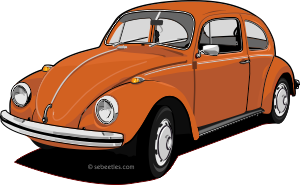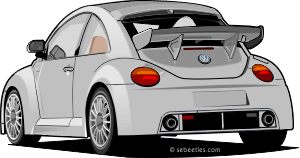FENDER BEETLE CONCEPT PAYS TRIBUTE TO A LEGENDARY BRAND
Fender provides inspiration for Volkswagen’s designers and engineers; an electric guitar can even be connected to the Fender sound system’s subwoofer!
Wolfsburg / Frankfurt, September 13, 2011 – The Beetle is the first car that can be ordered with a sound system by Fender, the guitar and amplifier maker. Now, at the IAA in Frankfurt, Volkswagen is presenting a concept car that can be interpreted as a tribute to the legendary U.S. company: the exclusive Fender Beetle with a customized design and features such as a sound-system interface for connecting an electric guitar.
Customized exterior
Outside, the Fender Beetle is painted in a high-gloss “Black”, with a fine red line framing the side windows; a Fender Telecaster customized by Volkswagen Design also shares this style.
The design of the Fender Beetle is also highlighted by chrome and aluminum. Chrome is used on the door mirror caps, door handles, the trim strip beneath the side windows, accents in the side sills, the VW badge and the two exhaust tailpipes. The caps and rings for the 19-inch version of the “Circle” aluminum-alloy wheels are produced from machine-polished aluminum.
The Fender Beetle is 0.4 inches wider at the rear than a regular Beetle and sits 1.2 inches lower, allowing the wheel-tire package to fill out the wheel housings more fully. Look closely and you will discern a couple of other neat details: a guitar pick decal on the hood and the original Fender signature (in chrome) located beneath the VW badge on the trunklid.
Eye-catching interior
The interior is also exceptionally well appointed. The dash pad has a striking “Sunburst” motif—the two-tone wood design pattern of many Fender guitars—integrated into it. This design extends across the dashboard in front of the driver and passenger and creates a visual link to the world of rock music.
The high-end Fender audio system has an auxiliary tube amplifier that is prominently displayed on top of the dash. Thanks to a special socket in the trunk, an electric guitar can be plugged in and plays over the subwoofer that is also integrated in the luggage compartment.
The Fender system is controlled via the RNS 510 radio-navigation system (which comes with a touchscreen and integrated 30-GB hard drive). Like the rotary knob for the RNS 510, the controls for the climate control system (temperature, air conditioning function, rear window defrost, and seat heating) were redesigned to look like those used for decades on guitar and bass amplifiers; in the Fender Beetle the controls are executed with typical Volkswagen high-end precision. A similar metal control is also used for adjusting the mirrors.
Another feature that’s tailored to musicians is a pick holder to the right of the DSG shift lever. The holder comes with three picks on which the outline of the Beetle is imprinted. Moreover, the band across the door storage bin features the Fender signature. Although the Fender Beetle is still a concept car, the “Fender Sound” can be ordered in the Beetle.
Fender sound system with ambient lighting
Buyers who choose the Fender audio system also get three-color ambient lighting for the interior in red, white, and blue. Along with indirect lighting in the door shoulder panels, there are also light rings around the loudspeaker boxes in the doors. The sound system itself has two sets of tweeters—one set by the door mirrors up front and one set mounted in the rear trim panels. These tweeters are equipped with neodymium magnets and fabric domes.
In the front doors, there are woofers with dual-voice coils, while the woofers located in the rear side trim each have a single voice coil. In addition, a subwoofer with a dual-voice coil is integrated in an enclosed bass box in the Beetle’s trunk. The centerpiece of the sound system is a 10-channel amplifier with Class A/B power amps and 400 Watts of output power.




















